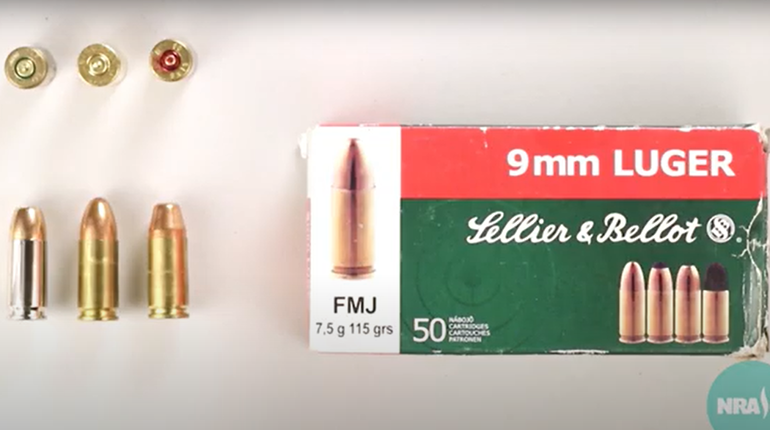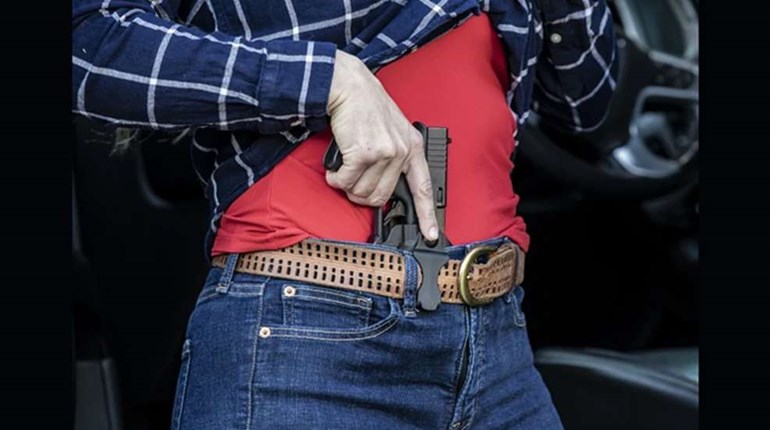
Photo by Dwight Burdette courtesy of Creative Commons (CC BY 3.0)
Given horrific events that have shaken our nation, we checked with Gunsite Academy Rangemaster Lew Gosnell about its class for church security teams. Gosnell, a former U.S. Marine and present-day police officer in Los Angeles, brings 44 years of street cred to the job. I have trained with him—in the Gunsite 250 pistol class—and can attest to his attention to detail on and off the range.
A1F: When was this class created and was it in response to a certain event?
Lew Gosnell: Discussion was held regarding “new classes” at Gunsite during the Rangemaster Conference, held in December 2014. This was prior to the Charlotte/Mecklenburg attack, but student interest had been expressed over several years, following the 2007 church attack at the Life Church, where Jeane Assam had engaged the killer. Arguably, her preparation and immediate response, with a service-size 9mm handgun, made a huge difference in the outcome. This type of planning and response was seen again in the White Settlement, Texas, attack.
During the discussion, I volunteered to look into the development of a Church Defense class and to see how much could be reasonably covered in a given time frame. We started with the idea of a two- or three-day class, but with what Gunsite Doctrine demanded, and what I learned from research, it became glaringly obvious that at a minimum we needed a five-day curriculum. There is simply too much information and too many skill sets to cover. I chose to make the class a response curriculum. I don’t delve too much in the backgrounds of the perpetrators, as this is one way to get lost in the weeds. I do talk about action, tactics used by the murderers in attacks, weapons and other minutia.
The class size, like most Gunsite classes, is limited to 24. We have had people from the same church, but due to travel and time, usually it is just one representative from a congregation, and usually the security director or supervisor, but also, often the pastor, priest or leader of the church.
Gunsite offers three Church Defense classes scheduled for 2020, and additional classes can be added when requested. The schedule has steadily grown since the first class in 2018. The class can go anywhere that a usable firing range is available, and a classroom that can support a PowerPoint presentation and lecture/discussion. Over the course of 5 days, the class is 45-plus hours total.
A1F: What equipment will a student need to bring to the Church Defense course?
Lew Gosnell: A student will need the following gear for the course:
A serviceable/reliable handgun, either semi-auto or revolver in a caliber that the student can manage, like .38 Special, 9 mm, etc. with three spare magazines/speed loaders; at least 750 rounds of ball ammo and 100 rounds of frangible ammo; a belt holster that is secure and allows ready access (we work to a 1.5-second head shot)(“Serpa” type holsters are banned; no reason to ask why, they are just a bad idea.); and, appropriate clothing for high-desert weather.
A1F: Is there anything else necessary to bring along to this class?
Lew Gosnell: Yes, attitude. This is where the rubber meets the road. Like a law enforcement or military question, we want to know if you are capable of using lethal force to stop another human being. We discuss this topic at length throughout the training course. Some students have discovered they are not mentally prepared for this eventuality. That is a good thing to know before you get into a gunfight.
A1F: What else do you stress during classroom time?
Lew Gosnell: Discussion covers layered defense, from outer grounds of a facility, to the inner sanctum. We talk about crime trends, such as burglary, sexual assault, domestic violence and crimes against children.
Reaching out to local police/sheriffs, for assistance in planning training is critical for being able to respond in a timely manner should an actual event occur. Your local agency will usually be happy to join in and help, and get a chance to use your building/place of worship for their own training.
A1F: What types of drills do you teach when in live fire scenarios on the ranges?
Lew Gosnell: The Church Defense class utilizes the same drills we require of any student in a Gunsite Defensive Handgun class. As always, the #1 rule at Gunsite includes the Four Rules of Firearms Safety:
- All guns are always loaded
- Never let the muzzle cover anything you are not willing to destroy
- Keep your finger off the trigger until your sights are on the target
- Be sure of your target
We teach these skills through drills:
- Safely presenting a loaded handgun from the holster, both from an exposed carry position and from concealment.
- Acquiring and understanding the “Flash Sight Picture,” trigger control and marksmanship fundamentals.
- Shooting from and around vehicles, as well as common uses of cover, barricades/corners/doorways.
- Crowd management, as in having to engage a threat with many people in the area. Square range drills, from contact distance to 25 yards and perhaps further.
- We cover torso and head shots.
- Threat discrimination, as in being able to identify what is and what is not a lethal threat, using lifelike targets.
- The last two days are dedicated to live-fire scenarios in shoot houses and force-on-force scenarios with live actors and paint-marking guns. Many of our students have commented that this training was the most important and beneficial they had ever received.
A1F: Why do you recommend this class to churches?
Lew Gosnell: We discuss these reasons at length during the class. We don’t lay out the best way to set up the security plan; we discuss and direct the planning to what will work best for the particular circumstances of each congregation. This is not Gunsite solving the problem, it’s the students. These are some of the factors each team must consider when planning a church-defense team.
- The availability of personnel with concealed-carry licenses.
- The “who” should be used in the capacity of a team member? Just having a permit may not constitute a good reason to be included on a church defense security team. Having a carry permit is certainly important in the states that don’t have constitutional carry, but many other aspects of individual character, trustworthiness, responsibility, maturity, good judgement, desire to serve and more are also critical.
- Also, currently serving or retired law enforcement or military may be present in the congregation and can be called upon.
- Understanding the importance of embracing the eventuality that time marches on, and with it the infirmities that will afflict all of us eventually. Knowing when to step back and let others carry the weight are addressed as well.
- Mitigating liability is another reason to seek further training. We don’t know what we don’t know. Years ago, I was involved in training a noted military organization. After several week-long classes, the unit canceled the training and started doing it entirely “in house.” A few years later, when tested, they realized that by not seeking out information from outside, their view was myopic. Professional training, such as that provided by Gunsite Academy, Inc., can show others that you are looking to protect your organization from criminals and from civil liability.
Learn more about Gunsite Academy’s Church Defense class.


































